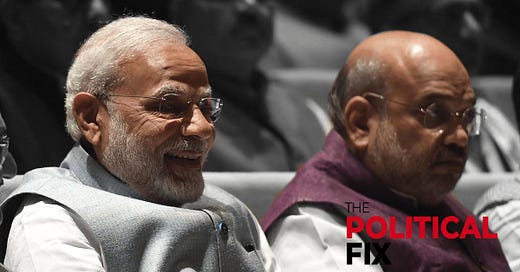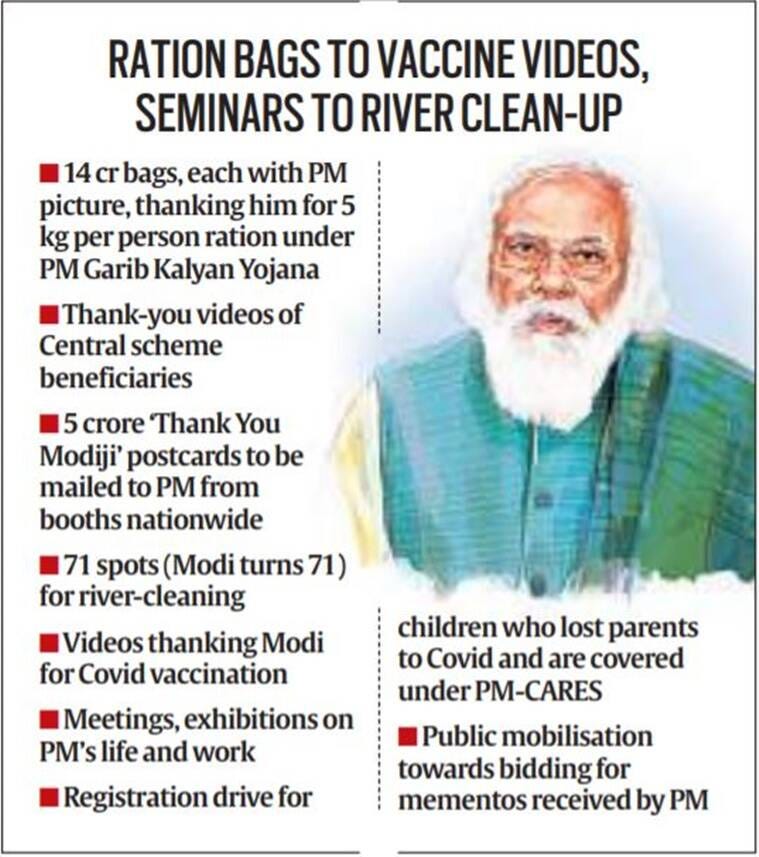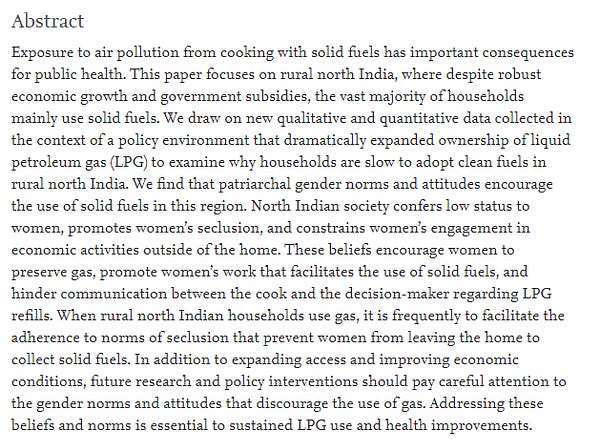The Political Fix: Is Modi's High Command culture turning some BJP CMs into glorified bureaucrats?
A newsletter on politics and policy from Scroll.in.
Welcome to The Political Fix by Rohan Venkataramakrishnan, a newsletter on Indian politics and policy. To get it in your inbox every week, sign up here.
Have you checked out Scroll.in’s new project, Common Ground, which offers in-depth and investigative reportage on our neglected commons? Get those stories in your inbox every Wednesday by signing up here.
And if you’d like to support the work we do at Scroll.in, contribute to the Ground Reporting Fund.
The Big Story: Disposable
One of the political phenomena of the Prime Minister Narendra Modi era that we have followed closely over the years on this newsletter is the apparent weakness of the Bharatiya Janata Party at the state level. Despite the party’s utter dominance at the national level, with Modi being by far the country’s most popular politician, the BJP has struggled to retain power in a number of states.
This trend has been amplified when the incumbent in a state assembly election has been a Modi-era chief minister, generally characterised as one without a mass base, frequently picked from a caste grouping that goes counter to prevailing political trends (a non-Jat in Haryana, a non-tribal in Jharkhand) and whose main claim to fame is a demonstrated loyalty to Modi.
Think of Manohar Lal Khattar in Haryana, who had to ally with a smaller party to remain in power in 2019, or Raghubar Das, who oversaw a major loss for the BJP in Jharkhand that year after just one term at the helm.
Political scientist Neelanjan Sircar has argued that this phenomenon is not an accident. It is an expected outcome of the tremendous centralisation within the BJP in the Modi era, with the party’s massive propaganda machinery focused on ensuring that any positives are attributed to the prime minister – where credit for things like welfare delivery may have once gone to the state-level leadership.
The BJP is not going to now undo this structure simply because it has led to poor results in state elections. Centralisation is a key plank of Modi and Home Minister Amit Shah’s approach to power, allowing them to minimise the factionalism that once plagued the BJP while also lending coherence to their overall political project. This is why political scientist Louise Tillin, on an earlier Q&A, described the current era as a “defining moment” for Indian federalism.
So how else can the BJP resolve its state-level handicap?
One approach to resolving this built-in weakness is to have chief ministers rely on an appeal that isn’t based on welfare delivery. Uttar Pradesh Chief Minister Yogi Adityanath’s strident anti-Muslim rhetoric and extra-judicial policing now seems to be a template that has been adopted by Assam’s Himanta Biswa Sarma. And even Madhya Pradesh Chief Minister Shivraj Singh Chouhan, whose original pre-Modi rise to power relied on the welfare delivery model, has sought to rework his image in the Adityanath mould.
Another tack is to treat chief ministers like governors or bureaucrats – portraying them to the public as able administrators appointed to the position just to carry out the wishes of Prime Minister Modi, who can be summarily transferred or dismissed by the BJP High Command if they have been adjudged incompetent.
Here’s the Indian Express from Gujarat, over this weekend:
“In a sudden move, Gujarat Chief Minister Vijay Rupani resigned Saturday, minutes after he had addressed an event of the Patidar community virtually inaugurated by Prime Minister Narendra Modi. Later, addressing mediapersons, he said the decision had been taken by the party “in the larger interest of Gujarat”.
Rupani’s resignation came with more than 14 months to go for his second term as CM. Considered an Amit Shah man, he had replaced Anandiben Patel in similar circumstances in August 2016, and celebrated five years of being in power recently.
Amid furious speculation over possible replacements for Rupani — including bitter rival and Deputy CM Nitin Patel — his resignation letter, released by the Chief Minister’s Office, said Modi was the face of the party in Gujarat and the next election would be fought under the PM’s leadership.”
The specific reasons for Rupani’s downfall are important to note.
He was responsible for colossal mismanagement of the Covid-19 crisis during the second wave earlier this year. For example, Rupani’s government made it mandatory for Coronavirus patients to only be admitted if they arrived in government-run ambulances – which were in short supply even as cases were skyrocketing – leading to tragic sights of people gathered outside hospitals desparate for admission.
A study found that just 54 of Gujarat’s 162 municipalities recorded 16,000 excess deaths between March 2020 and April 2021, a figure that is 60% higher than the official state-wide count of Covid-19 deaths of 10,080. Few need to be reminded of the visuals of chimneys melting at crematoriums because of the sheer numbers of bodies, or the rare decision by mainstream new organisations to actually report on the government’s fudging of casualty figures.
This added to a sense of occasional administrative difficulties, and regular clashing with other power centres within the Gujarat BJP.
Rupani – who comes from the Jain community – also struggled to handle the political fault-line that has been most contentious in Gujarat politics over the last few years: Demands from the dominant Patidar community for reservations and a bigger share of power.
In fact, Rupani’s predecessor, Anandiben Patel, the unexpected pick to replace Modi as chief minister after he moved to New Delhi in 2014 was similarly shunted from the post ahead of state elections in 2017 reportedly for her failure to handle the Patidar agitation.
It is no surprise that nearly all of the politicians being discussed to take over from Rupani were from the Patidar community. In characteristic fashion, though, none of the bigger names – such as deputy chief minister and mass leader Nitin Patel – were picked. Instead, Modi and Shah went with Bhupendra Patel, a first-time Member of the Legislative Assembly, believed to be close to former chief minister Anandiben Patel.



The choice of Bhupendra Patel reiterates some elements of the Modi-Shah approach to dealing with state-level politics, while also displaying certain fresh tactics that have been experimented with this year.
First, the familiar notes:
The dismissal of Rupani and the selection of the new chief minister reiterates the severe High Command-style centralisation within the BJP under Modi and Shah, something we wrote about in the context of Karnataka last year.
The choice of a lesser-known face maintains the approach used earlier and elsewhere, clearly sending the message that the new chief minister is only in charge at the whim of the Delhi High Command.
This is an aside, but the utter surprise among the mainstream media only confirms the sense that while it has become heavily pro-government over the last seven years, that has not meant any particular insight into the workings of the Modi-Shah BJP.
A further aside – Dhaval Patel, who wrote about a possible change within the Gujarat BJP back in mid-2020 was absurdly slapped with a sedition charge and had to spend 14 days in jail.
Next, the somewhat new elements:
Unlike the choice of Rupani or other non-dominant community leaders elsewhere, the BJP has evidently had to accede to demands from the dominant caste Patidars with elections around the corner.
Unlike Jharkhand in 2019, where the BJP sought to stick with the incumbent chief minister despite signs of unpopularity, the party has taken a call to bring in a fresh face from the dominant community in the hopes of addressing popular discontent.
The move follows a similar change of guard in Uttarakhand earlier this year, where elections are also due next year. There, an unpopular Trivendra Singh Rawat was replaced by Tirath Singh Rawat, who had to himself step down just four months later, giving way to Pushkar Singh Dami, in part because of technical reasons.
The switchover in Karnataka, just two months ago, is somewhat different and yet has shades of these maneuvers. The BJP finally managed to get BS Yediyurappa to step down with causing too much of a fuss, in part because his replacement – Basavaraj Bommai – came from his camp, and hails from the dominant Lingayat community. Not all is well there, however, with Amit Shah’s statement last week that Bommai would lead the BJP into the next elections in 2023 being seen as an attempt to put a lid on the internal jostling that continued to take place.
As mentioned above, the Assam situation is almost a perfect encapsulation of one of these strategies, albeit taking place smoothly after a victorious election result (instead of before polls, or in response to poor results). The welfare-delivery focused Sarbananda Sonowal gave way, after a successful re-election campaign, to Himanta Biswa Sarma, who has immediately struck a much harsher Hindutva tone.
The fact that the BJP has had to make these moves in four different states over the course of the last few months is a clear indication that the past year of price rise and Covid-19 mismanagement is being felt at some level.
The churn may be tactical, and the convenience of a docile mainstream media means it will not be depicted as disarray – even though that would most likely have been the label placed on the Congress if it were facing the same – yet no one can argue that it does not represent damage control for the BJP. For long many have wondered how the effects of the Great Indian Slowdown, which predated the pandemic, and the Covid-19 mismangement will play out. This course correction is at least one answer.
The state leadership changes also allow Modi to protect his own image, deflecting blame onto his local lieutenants and relying on the promise of more competent replacements as a way to mollify the unhappy public.
If you were in doubt about the second prong of this maneuver, take a look at what the BJP has planned for later this month, according to the Indian Express’ Ravish Tiwari:
“From 14 crore ration bags printed with his picture to 5 crore “Thank-you Modiji” postcards mailed from booths nationwide, identifying 71 spots for clean-up in rivers to a high-voltage social media campaign showcasing vaccination videos and seminars on his life and work: these are among the key elements of a three-week-long campaign the BJP will roll out to showcase Prime Minister Narendra Modi.
Timed with his 71st birthday (September 17) and 20 years of his public life as an administrator (October 7, 2001, when he first became Gujarat CM), this unprecedented drive holds significance in the wake of the brutal second wave of the Covid pandemic.”
Also read:
Liz Mathew and Leena Misra add in useful details about the Gujarat developments, including this: “Rupani’s resignation came, as Paryushan, the period of penance for Jains ended Saturday, when the community seeks forgiveness.”
Mahesh Langa says the choice of Bhupendra Patel was also made “probably to counter the Aam Aadmi Party’s efforts to gain a foothold in Gujarat’s cities.”
Deepal Trivedi lists out the reasons Rupani had to go.
Radhika Ramaseshan on the caste politics at play in Gujarat.
Linking Out
Income Tax officials conducted ‘surveys’ of independent news organisations, Newslaundry and Newsclick, both of which coincidentally do not toe the government line on all matters.
Political scientists Suhas Palshikar and E Sridharan discuss whether the first-past-the-post system is to blame for the current polarisation in the Indian polity.


Montek Singh Ahluwalia and Ajay Shah discuss whether the national monetisation pipeline – which I wrote about a few weeks ago – is a good idea.
Navdeep Suri explains what’s wrong with the Jallianwala Bagh makeover in Amritsar.
Vijay Kelkar and Niranjan Rajadhyaksha call for a ‘Vajpayee moment’ in Indian telecom, saying the government has to find an innovative solution for the industry’s current woes that would benefit citizens.

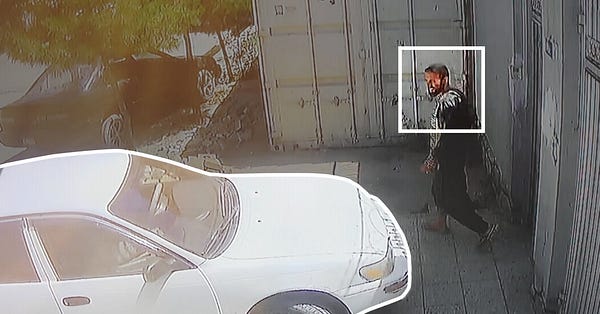
Can’t Make This Up
The first three pages of the Indian Express on Sunday turned out to be ‘advertorial’ dedicated to describing how Uttar Pradesh had transformed under Chief Minister Yogi Adityanath. The front page included an image of Adityanath standing above a modern looking flyover and some industrial buildings, as well as a quote from the chief minister saying, “before 2017, people from outside used to laugh as soon as they used to hear the name of Uttar Pradesh in the context of investment…”
Unfortunately, it soon emerged that the flyover depicted was in Kolkata, West Bengal…

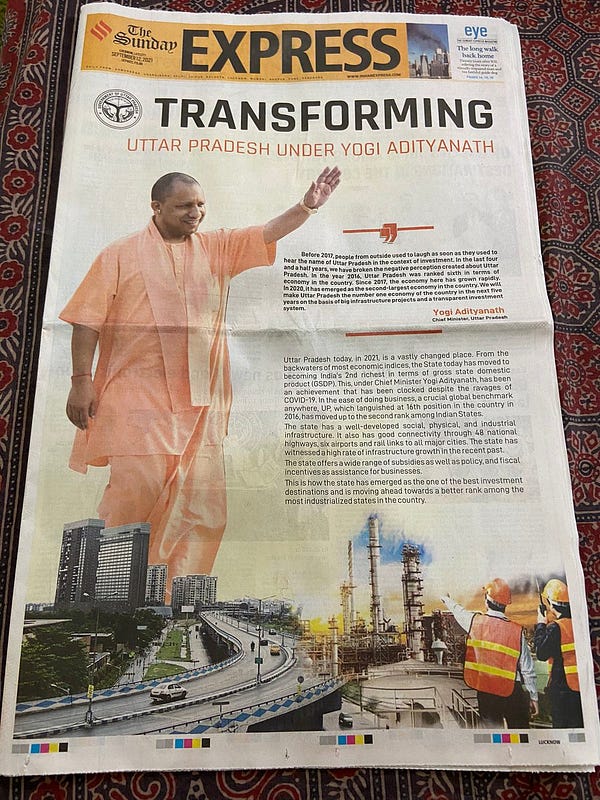
Thanks for reading the Political Fix. Send feedback to rohan@scroll.in.

